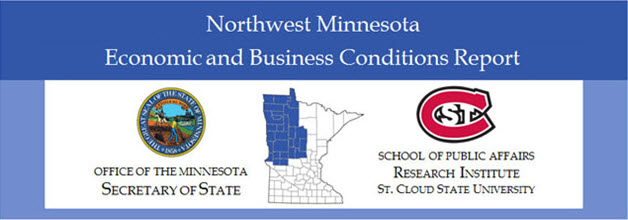Document Type
Research Study
Publication Date
8-2016
Abstract
The Northwest Minnesota planning area economy is expected to grow at a slower pace than normal over the next several months according to the predictions of the St. Cloud State University (SCSU) Northwest Minnesota Index of Leading Economic Indicators (LEI). Three of the five components of the leading index were lower in the second quarter, causing the LEI to decrease by 3.66 points. A declining Rural Mainstreet Index (which signals a more challenging macroeconomic environment for rural America), a smaller number of residential building permits in Fargo/Moorhead and Grand Forks/East Grand Forks, and lower new filings for incorporation and LLC helped drive the index lower. Improved consumer sentiment was the only index component that helped lift the index. A fifth LEI component (initial jobless claims) was largely neutral.
There were 1,088 new business filings with the Office of the Minnesota Secretary of State in Northwest Minnesota in the second quarter of 2016 — representing a 3.6 percent decrease from one year ago. 119 new regional business incorporations were recorded in the most recent quarter, which was basically unchanged from the same quarter in 2015. In the second quarter, new LLC filings in Northwest Minnesota were down 6.4 percent from one year earlier—falling to 575. New assumed names totaled 346 in the second quarter—0.9 percent more filings than the same period in 2015. There were 48 new filings for Northwest Minnesota non-profits in the second quarter—six fewer filings than one year ago.
Employment of Northwest Minnesota residents declined by 0.6 percent over the year ending June 2016. The regional unemployment rate was 4.5 percent in June, which was higher than the 4.3 percent rate observed one year ago. The Northwest Minnesota labor force contracted over the past twelve months (there are now 1,260 fewer people in the regional labor force than there was one year ago). Initial claims for unemployment insurance in June were essentially unchanged from June 2015. The average weekly wage rose to $767 in Northwest Minnesota in the fourth quarter of 2015. This is the lowest average weekly wage of Minnesota’s six planning areas. The region’s total bankruptcies have begun to level out at an historically low level.
The Fargo/Moorhead Metropolitan Statistical Area (MSA) experienced a mixed economic performance over the past quarter. This MSA tallied gains in overall employment and in mining, logging and construction employment (but decreased manufacturing employment), lower initial jobless claims, and a rise in the regional workforce. This was offset by reduced valuation of residential building permits, a lower average workweek, weaker average hourly earnings, an increased unemployment rate, and a jump in the relative cost of living. Economic activity in the Grand Forks/East Grand Forks MSA was similarly mixed in the second quarter. Higher overall employment (as well as in two key sectors), a rising labor force, higher average hourly earnings, a longer workweek, and an increase in the value of residential building permits all contributed favorably to the overall economy. An increase in the regional unemployment rate and in initial jobless claims weighed negatively on Grand Forks/East Grand Forks in the second quarter.
Recommended Citation
Banaian, King and MacDonald, Richard A., "Northwest Minnesota Economic and Business Conditions Report - Second Quarter 2016" (2016). Northwest Minnesota Economic and Business Conditions Report. 10.
https://repository.stcloudstate.edu/qebcr_nw_mn/10




